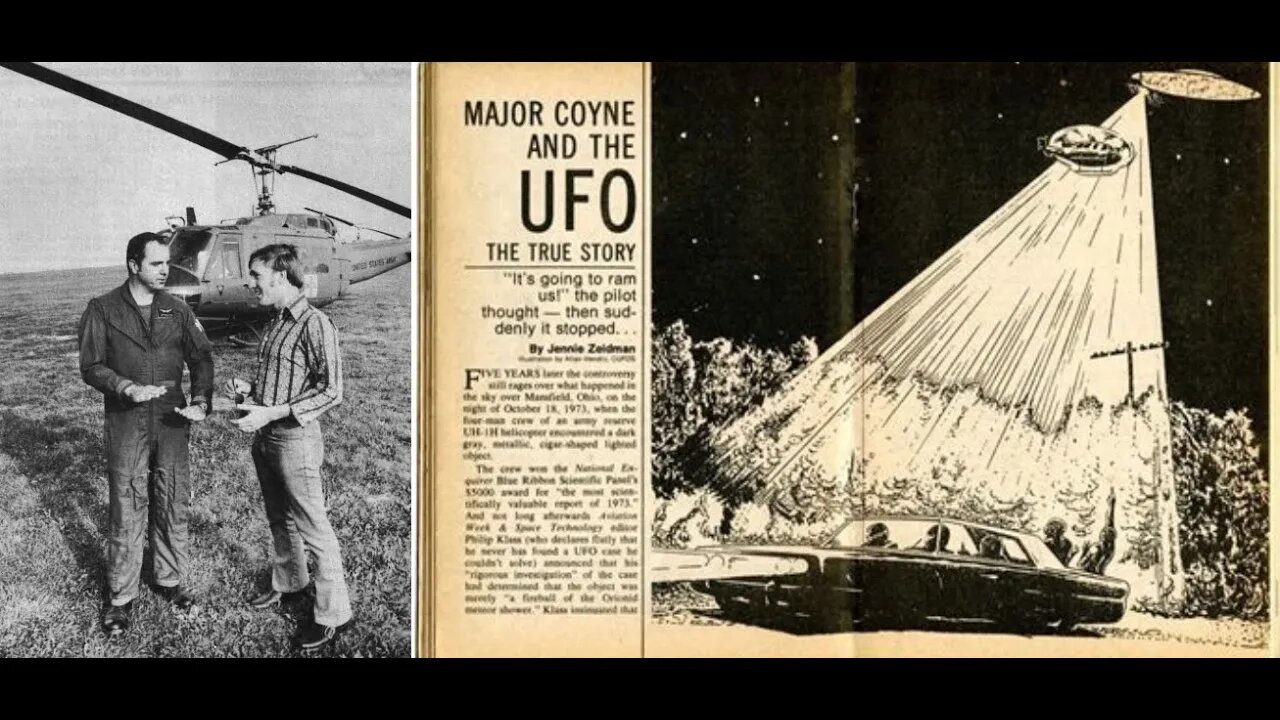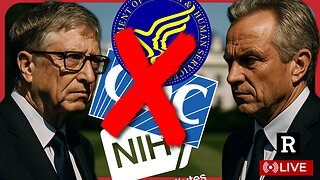Premium Only Content

US Army Helicopter Attacked By UFO- The Coyne Incident Ohio 1973
Date: October 18, 1973
Location: Mansfield, Ohio, United States
The Coyne case (or “Army helicopter incident”) stands out as, perhaps the most credible (in the “high strangeness” category) of the 1973 wave. An Army Reserve helicopter crew of four men encountered a gray, metallic-looking, cigar-shaped object, with unusual lights and maneuvers, as they were airborne between Columbus and Cleveland, Ohio.
On October 18, 1973, at approximately 10:30 PM a UH-1H helicopter of the United States Army Reserve left Port Columbus, Ohio, for its home base of Cleveland Hopkins airport, ninety-six nautical miles to the north-northeast. In command, in the right-front seat, was Captain Lawrence J. Coyne, thirty-six, with nineteen years of flying experience. At the controls, in the left-front seat, sat First Lieutenant Arrigo Jezzi, twenty-six, a chemical engineer. Behind Jezzi sat Sergeant John Healey, thirty-five, a Cleveland policeman who was the flight medic, and Coyne was the Crew Chief, Sergeant Robert Yanacsek, twenty-three, a computer technician. The helicopter was cruising at 2,500 feet above sea level at an indicated airspeed of ninety knots, above mixed hills, woods, and rolling farmland, averaging 1,200 feet elevation. The night was totally clear, calm, and starry. The last quarter moon was just rising.
After an estimated additional thirty seconds, Yanacsek announced that the light had turned toward the helicopter and appeared to be on a converging flight path. Coyne verified Yanacsek’s assessment, grabbed the controls from Jezzi, and put the UH-1H into a powered descent of approximately 500 feet per minute. Almost simultaneously, Coyne established radio contact with Mansfield control tower, ten miles to the northwest. Coyne thought the flight was an Air National Guard F-100 from Mansfield. After an initial acknowledgment (“This is Mansfield Tower, go ahead Army 1-5-triple-4”), radio contact failed. Jezzi then attempted transmission on both UHF and VHF frequencies without success.
The red light continued its radial bearing and increased greatly in intensity. Coyne increased his rate of descent to 2,000 feet per minute and his airspeed to 100 knots. The last altitude he noted was 1,700 feet. Just as a collision appeared imminent, the unknown light halted in its westward course and assumed a hovering relationship above and in front of the helicopter. “It wasn’t cruising, it was stopped. For maybe ten to twelve seconds – just stopped,” Yanacsek reported. Coyne, Healey, and Yanacsek agree that a cigar-shaped, slightly domed object substended an angle of nearly the width of the front windshield. A featureless, gray, metallic-looking structure was precisely delineated against the background stars. Yanacsek reported “a suggestion of windows” along the top dome section. The red light emanated from the bow, a white light became visible at a slightly indented stern, and then, from aft/below, a green ‘pyramid shaped” beam equated to a directional spotlight became visible. The green beam passed upward over the helicopter nose, swung up through the windshield, continued upward and entered the tinted upper window panels.
At that point (and not before), the cockpit was enveloped in green light. Jezzi reported only a bright white light, comparable to the leading light of a small aircraft, visible through the top “greenhouse’ panels of the windshield. After the estimated ten seconds of “hovering,” the object began to accelerate off to the west, now with only the white “tail” light visible. The white light maintained its intensity even as its distance appeared to increase, and finally (according to Coyne and Healey), it appeared to execute a decisive 45 degree turn to the right, head out toward Lake Erie, and then “snap out” over the horizon. Healey reported that he watched the object moving westward “for a couple of minutes.” Jezzi said it moved faster than the 250-knot limit for aircraft below 10,000 feet, After the object had broken off its hovering relationship, Jezzi and Coyne noted that the magnetic compass disk was rotating approximately four times per minute and that the altimeter read approximately 3,500 feet; a 1,000 foot-per-minute climb was in progress. Coyne insists that the collective was still bottomed from his evasive descent. Since the collective could not be lowered further, he had no alternative but to lift it, whatever the results, and after a few seconds of gingerly maneuvering controls (during which the helicopter reached nearly 3,800 feet), positive control was achieved. By that time the white light had already moved into the Mansfield area. Coyne had been subliminally aware of the climb; the others not at all, yet they had all been acutely aware of the g-forces of the dive. The helicopter was brought back to the flight plan altitude of 2,500 feet, radio contact was achieved with Canton/Akron, and the flight proceeded uneventfully to Cleveland.
-
 LIVE
LIVE
Kim Iversen
2 hours agoTrans. Russian. Anti-Israel. Anti-Trump. Are You Buying This Story?
1,892 watching -
 1:51:08
1:51:08
Redacted News
2 hours agoEMERGENCY! BILL GATES CULT MEMBERS FOUND PLANTED INSIDE MULTIPLE FEDERAL AGENCIES, RFK FURIOUS
91K49 -
 31:02
31:02
Kimberly Guilfoyle
3 hours agoFull Breaking News Coverage: Live with John Nantz & Steve Moore | Ep250
11.4K5 -
 1:15:19
1:15:19
vivafrei
4 hours agoShameless Politicization of Tragedy! Susan Monarez is OUT! Pritzker is an IDIOT! & MORE!
98.6K40 -
 LIVE
LIVE
Tundra Tactical
1 hour agoCracker Meme Review On Tundra Meme Review!!
68 watching -
 UPCOMING
UPCOMING
Wayne Allyn Root | WAR Zone
4 hours agoWAR Zone LIVE | 28 AUGUST 2025
18 -
 LIVE
LIVE
LFA TV
10 hours agoLFA TV ALL DAY STREAM - THURSDAY 8/28/25
1,361 watching -
 LIVE
LIVE
freecastle
3 hours agoTAKE UP YOUR CROSS- CREATED IN HIS IMAGE
157 watching -
 1:49:30
1:49:30
The Quartering
4 hours agoCount Dankula Live On Migrant Crisis In Europe, Whiteness & More
121K162 -
 3:46:59
3:46:59
Barry Cunningham
8 hours agoBREAKING NEWS: KAROLINE LEAVITT HOLDS WHITE HOUSE PRESS CONFERENCE (AND MORE NEWS)
72K54